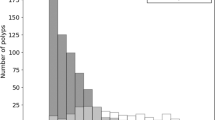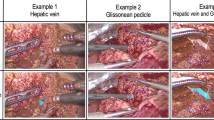Abstract
Purpose
In this study, we propose a deep learning approach for assessment of gallbladder (GB) wall vascularity from images of laparoscopic cholecystectomy (LC). Difficulty in the visualization of GB wall vessels may be the result of fatty infiltration or increased thickening of the GB wall, potentially as a result of cholecystitis or other diseases.
Methods
The dataset included 800 patches and 181 region outlines of the GB wall extracted from 53 operations of the Cholec80 video collection. The GB regions and patches were annotated by two expert surgeons using two labeling schemes: 3 classes (low, medium and high vascularity) and 2 classes (low vs. high). Two convolutional neural network (CNN) architectures were investigated. Preprocessing (vessel enhancement) and post-processing (late fusion of CNN output) techniques were applied.
Results
The best model yielded accuracy 94.48% and 83.77% for patch classification into 2 and 3 classes, respectively. For the GB wall regions, the best model yielded accuracy 91.16% (2 classes) and 80.66% (3 classes). The inter-observer agreement was 91.71% (2 classes) and 78.45% (3 classes). Late fusion analysis allowed the computation of spatial probability maps, which provided a visual representation of the probability for each vascularity class across the GB wall region.
Conclusions
This study is the first significant step forward to assess the vascularity of the GB wall from intraoperative images based on computer vision and deep learning techniques. The classification performance of the CNNs was comparable to the agreement of two expert surgeons. The approach may be used for various applications such as for classification of LC operations and context-aware assistance in surgical education and practice.







Similar content being viewed by others
References
Zeng C, Xing W, Wu Z, Huang H, Huang W (2016) A combination of three-dimensional printing and computer-assisted virtual surgical procedure for preoperative planning of acetabular fracture reduction. Injury 47:2223–2227
Loukas C, Nikiteas N, Kanakis M, Georgiou E (2011) The contribution of simulation training in enhancing key components of laparoscopic competence. Am Surg 77:708–715
Vedula SS, Ishii M, Hager GD (2017) Objective assessment of surgical technical skill and competency in the operating room. Annu Rev Biomed Eng 19:301–325
Maier-Hein L, Vedula SS, Speidel S, Navab N, Kikinis R, Park A, Eisenmann M, Feussner H, Forestier G, Giannarou S, Hashizume M, Katic D, Kenngott H, Kranzfelder M, Malpani A, März K, Neumuth T, Padoy N, Pugh C, Schoch N, Stoyanov D, Taylor R, Wagner M, Hager GD, Jannin P (2017) Surgical data science for next-generation interventions. Nat Biomed Eng 1:691–696
Bodenstedt S, Wagner M, Mündermann L, Kenngott H, Müller-Stich B, Breucha M, Mees ST, Weitz J, Speidel S (2019) Prediction of laparoscopic procedure duration using unlabeled, multimodal sensor data. Int J Comput Assist Radiol Surg 14:1089–1095
Loukas C (2018) Video content analysis of surgical procedures. Surg Endosc 32:553–568
Loukas C, Georgiou E (2013) Surgical workflow analysis with Gaussian mixture multivariate autoregressive (GMMAR) models: a simulation study. Comput Aided Surg 18:47–62
Twinanda AP, Yengera G, Mutter D, Marescaux J, Padoy N (2019) RSDNet: learning to predict remaining surgery duration from laparoscopic videos without manual annotations. IEEE Trans Med Imaging 38:1069–1078
Loukas C, Georgiou E (2015) Smoke detection in endoscopic surgery videos: a first step towards retrieval of semantic events. Int J Med Robot Comput Assist Surg 11:80–94
Funke I, Mees ST, Weitz J, Speidel S (2019) Video-based surgical skill assessment using 3D convolutional neural networks. Int J Comput Assist Radiol Surg 14:1217–1225
Loukas C, Varytimidis C, Rapantzikos K, Kanakis MA (2018) Keyframe extraction from laparoscopic videos based on visual saliency detection. Comput Methods Progr Biomed 165:13–23
Lalys F, Bouget D, Riffaud L, Jannin P (2013) Automatic knowledge-based recognition of low-level tasks in ophthalmological procedures. Int J Comput Assist Radiol Surg 8:39–49
Loukas C, Sgouros NP (2020) Multi-instance multi-label learning for surgical image annotation. Int J Med Robot Comput Assist Surg 16:1–12
Zadeh SM, Francois T, Calvet L, Chauvet P, Canis M, Bartoli A, Bourdel N (2020) SurgAI: deep learning for computerized laparoscopic image understanding in gynaecology. Surg Endosc (in press)
Baghdadi A, Hussein AA, Ahmed Y, Cavuoto LA, Guru KA (2019) A computer vision technique for automated assessment of surgical performance using surgeons’ console-feed videos. Int J Comput Assist Radiol Surg 14:697–707
Derathé A, Reche F, Moreau-Gaudry A, Jannin P, Gibaud B, Voros S (2020) Predicting the quality of surgical exposure using spatial and procedural features from laparoscopic videos. Int J Comput Assist Radiol Surg 15:59–67
Garcia-Martinez A, Vicente-Samper JM, Sabater-Navarro JM (2017) Automatic detection of surgical haemorrhage using computer vision. Artif Intell Med 78:55–60
Petscharnig S, Schöffmann K (2018) Binary convolutional neural network features off-the-shelf for image to video linking in endoscopic multimedia databases. Multimed Tools Appl 77:28817–28842
Iwashita Y, Hibi T, Ohyama T, Honda G, Yoshida M, Miura F, Takada T, Han H-S, Hwang T-L, Shinya S, Suzuki K, Umezawa A, Yoon Y-S, Choi I-S, Huang WS-W, Chen K-H, Watanabe M, Abe Y, Misawa T, Nagakawa Y, Yoon D-S, Jang J-Y, Yu HC, Ahn KS, Kim SC, Song IS, Kim JH, Yun SS, Choi SH, Jan Y-Y, Shan Y-S, Ker C-G, Chan D-C, Wu C-C, Lee K-T, Toyota N, Higuchi R, Nakamura Y, Mizuguchi Y, Takeda Y, Ito M, Norimizu S, Yamada S, Matsumura N, Shindoh J, Sunagawa H, Gocho T, Hasegawa H, Rikiyama T, Sata N, Kano N, Kitano S, Tokumura H, Yamashita Y, Watanabe G, Nakagawa K, Kimura T, Yamakawa T, Wakabayashi G, Mori R, Endo I, Miyazaki M, Yamamoto M (2017) An opportunity in difficulty: Japan–Korea–Taiwan expert Delphi consensus on surgical difficulty during laparoscopic cholecystectomy. J Hepatobiliary Pancreat Sci 24:191–198
Hayama S, Ohtaka K, Shoji Y (2016) Risk factors for difficult laparoscopic cholecystectomy in acute cholecystitis. J Soc Laparoendosc Surg 20:1–8
Van Breda Vriesman AC, Engelbrecht MR, Smithuis RHM, Puylaert JBCM (2007) Diffuse gallbladder wall thickening: differential diagnosis. Am J Roentgenol 188:495–501
Loukas C, Schizas D (2020) Assessment of gallbladder wall vascularity from laparoscopic images using deep learning. In: Proceedings of 13th international joint conference biomedical engineering systems and technologies, vol. 2 Bioimaging. Valletta, Malta, pp 28–36
Twinanda AP, Shehata S, Mutter D, Marescaux J, de Mathelin M, Padoy N (2017) EndoNet: A deep architecture for recognition tasks on laparoscopic videos. IEEE Trans Med Imaging 36:86–97
Lux M, Marques O (2013) Visual information retrieval using Java and LIRE. Synth Lect Inf Concepts Retr Serv. https://doi.org/10.2200/S00468ED1V01Y201301ICR025
Vallières M, Freeman CR, Skamene SR, El Naqa I (2015) A radiomics model from joint FDG-PET and MRI texture features for the prediction of lung metastases in soft-tissue sarcomas of the extremities. Phys Med Biol 60:5471–5496
Simonyan K, Zisserman A (2014) Very deep convolutional networks for large-scale image recognition. https://arxiv.org/abs/1409.1556
He K, Zhang X, Ren S, Sun J (2016) Deep residual learning for image recognition. In: IEEE conference on computer vision and pattern recognition. IEEE, Las Vegas, USA, pp 770–778
Schols RM, Bouvy ND, van Dam RM, Masclee AAM, Dejong CHC, Stassen LPS (2013) Combined vascular and biliary fluorescence imaging in laparoscopic cholecystectomy. Surg Endosc 27:4511–4517
Uggowitzer M, Kugler C, Schramayer G, Kammerhuber F, Gröll R, Hausegger KA, Ratschek M, Quehenberger F (1997) Sonography of acute cholecystitis: comparison of color and power Doppler sonography in detecting a hypervascularized gallbladder wall. Am J Roentgenol 168:707–712
Kim J, Candemir S, Chew EY, Thoma GR (2018) Region of interest detection in fundus images using deep learning and blood vessel information. In: International symposium on computer-based medical systems. IEEE, Karlstad, Sweden, pp 357–362
Jin Y, Dou Q, Chen H, Yu L, Qin J, Fu C-W, Heng P-A (2018) SV-RCNet: Workflow recognition from surgical videos using recurrent convolutional network. IEEE Trans Med Imaging 37:1114–1126
Funding
None.
Author information
Authors and Affiliations
Corresponding author
Ethics declarations
Conflict of interest
The authors declare that they have no conflict of interest.
Ethical approval
This article does not contain any studies with human participants or animals performed by any of the authors.
Informed consent
For this type of study, formal consent is not required. Used data were anonymously available through the Cholec80 video dataset.
Additional information
Publisher's Note
Springer Nature remains neutral with regard to jurisdictional claims in published maps and institutional affiliations.
Rights and permissions
About this article
Cite this article
Loukas, C., Frountzas, M. & Schizas, D. Patch-based classification of gallbladder wall vascularity from laparoscopic images using deep learning. Int J CARS 16, 103–113 (2021). https://doi.org/10.1007/s11548-020-02285-x
Received:
Accepted:
Published:
Issue Date:
DOI: https://doi.org/10.1007/s11548-020-02285-x




